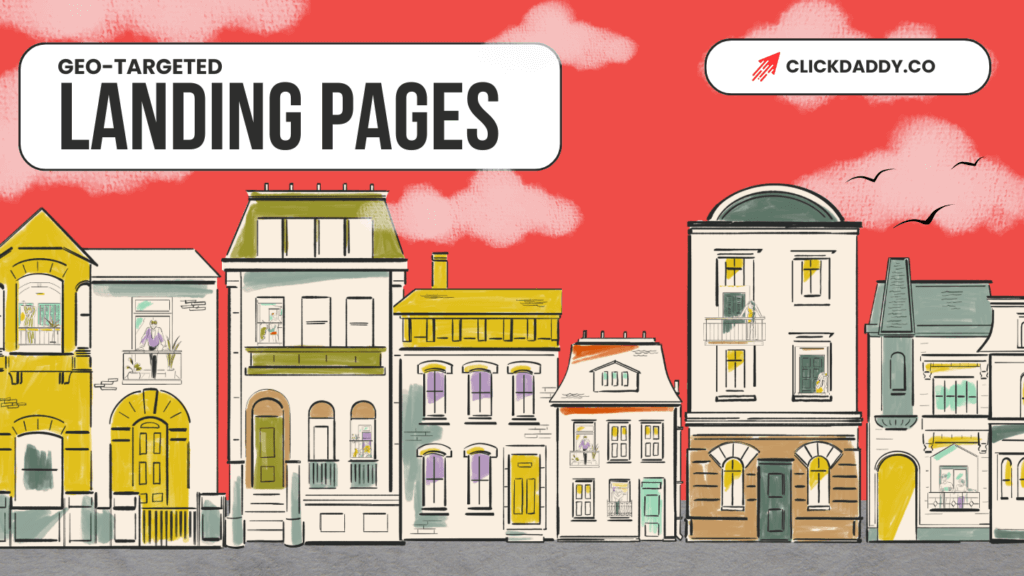As a small business owner in Jefferson City, you know the importance of connecting with local customers. Did you know that 46% of all Google searches are seeking local information?
This means potential customers are actively looking for services like yours in your area.
At ClickDaddy SEO, we’ve seen firsthand how geo-targeted landing pages can boost local visibility. By creating pages tailored to specific locations, businesses can rank higher in local searches, attracting more nearby customers.
In this guide, we’ll show you how to create effective geo-targeted landing pages to enhance your local SEO and connect with your community. Let’s get started!
Key Takeaways
- Geo-targeted landing pages attract local customers by focusing on location keywords and relevant content.
- Local search is 46% of Google searches, showing the importance of targeting nearby audiences.
- Effective pages use location keywords, consistent NAP info, and local testimonials.
- SEO best practices include unique content, mobile-friendliness, and geo-targeted meta tags.
- Track and adjust with analytics to boost local visibility and conversions.
- Geo-targeted pages improve local SEO, connecting customers to your business.
What Are Geo-Targeted Landing Pages?
Geo-targeted landing pages are specific web pages designed to attract visitors from a particular location. These pages focus on local keywords, such as “plumbing services in Jefferson City” or “top-rated coffee shop in Columbia.”
Using location-based content can help search engines understand which areas we serve, making it easier for local customers to find us.
For example, let’s say you’re a landscaping company that serves multiple areas. You could create separate pages for each city, like “Landscaping Services in Jefferson City” and “Lawn Care in Columbia.” This way, when someone searches for these services in a specific location, they’ll be directed to the most relevant page.
Geo-targeted landing pages are essential for small businesses aiming to grow their local presence. With 46% of Google searches looking for local information, these pages can make a big difference in connecting with potential customers nearby.
Why Geo-Targeted Landing Pages Matter for SEO
Geo-targeted landing pages are a game-changer for improving your local search visibility. When you create pages that focus on specific areas, search engines recognize that your business serves those locations. This increases the chances of your site appearing when people in those areas search for services like yours.
Local searches have become more popular, with studies showing that 76% of people who search for something nearby visit a business within a day. This means that geo-targeted pages don’t just improve visibility—they bring in customers who are ready to take action. For small businesses, this is huge.
Beyond boosting search engine rankings, geo-targeted pages make it clear to your customers that you understand and care about their specific needs in their area. When customers see that your business knows their neighborhood or city, they’re more likely to trust your brand and choose your services.
Local Search: Less Competitive
Local search is also less competitive than trying to rank for national keywords. Instead of competing with hundreds of businesses across the country, you’re only competing with those in your specific area. This makes it easier for your business to rank higher in search results for relevant, local searches.
For example, ranking for “plumbing services in Jefferson City” is far more achievable than just “plumbing services.”
By targeting local keywords on your geo-targeted landing pages, you can see results faster and connect with customers who are actively looking for services nearby.
This targeted approach not only helps improve your SEO but also drives quality traffic that’s more likely to convert.
Key Elements of an Effective Geo-Targeted Landing Page
Creating a geo-targeted landing page requires more than just adding a city name. Here are the essential elements that make these pages effective for SEO and user engagement:
1. Location-Specific Keywords
Use keywords that include your target location, like “landscaping in Jefferson City” or “best restaurant in Columbia.”
Place these keywords naturally in your title, headings, and throughout the content. This helps search engines know exactly which area your page is focused on, increasing its relevance for local searches.
2. Localized Content
Your content should speak to the local audience. Mention landmarks, neighborhoods, or local events to make the page feel relevant to the community.
For example, a roofing company could reference local weather patterns and how their services help protect homes in the area. This type of personalized content strengthens your connection with local customers and boosts trust.
3. NAP (Name, Address, Phone Number) Consistency
Make sure your business’s name, address, and phone number (NAP) are consistent across all geo-targeted pages and match your Google My Business listing. This consistency is essential for local SEO, as search engines use this information to verify your business’s legitimacy and location.
4. Map Integration
Embedding a Google Map on your landing page helps local customers find your location easily and adds a strong local signal for search engines.
For multi-location businesses, add a map centered on the specific branch or office for each geo-targeted page. This makes it clear where customers can find you and supports your local relevance.
5. Local Testimonials or Case Studies
Showcasing testimonials or case studies from local customers can significantly enhance your credibility.
For instance, if you’re a Jefferson City landscaping business, including a quote from a Jefferson City client or a case study of a completed project nearby adds social proof. It reassures potential customers that you’re active in the community and trusted by other locals.
Incorporating these elements can help make your geo-targeted landing pages effective, not only improving your SEO but also increasing the chances of converting local visitors into customers
SEO Best Practices for Geo-Targeted Landing Pages
To make your geo-targeted landing pages as effective as possible, follow these SEO best practices. These steps will help your pages rank higher and attract more local customers.
1. Optimize for Location Keywords
Use your primary location-based keyword in essential spots, like the page title, meta description, headers, and throughout the content.
For example, if you’re targeting “Plumbing Services in Jefferson City,” include this phrase naturally in each section. This helps search engines know what the page is about and which location it serves.
2. Create Unique Content for Each Location
Avoid duplicating content across different geo-targeted pages, as search engines can penalize duplicate content.
Instead, tailor each page to its specific location. Mention local events, customer stories, or community details that make each page unique.
This approach not only prevents duplication issues but also makes each page more relevant and engaging for local visitors.
3. Use Geo-Targeted Meta Tags
Incorporate location-based keywords in your meta tags, including the title tag and meta description.
For example, a title tag for a landscaping page could be “Landscaping Services in Jefferson City | [Your Business Name].”
A clear, geo-specific meta description also encourages local visitors to click through to your page.
4. Add Alt Text with Location Information
When you include images on your landing page, add descriptive alt text that includes location keywords. For instance, an image of a Jefferson City landscaping project might have alt text like “Jefferson City landscaping project by [Your Business Name].”
This not only helps with SEO but also ensures that your images are accessible to all users.
5. Keep Your Page Mobile-Friendly
Local searches often happen on mobile devices, so a mobile-friendly design is essential.
Ensure your geo-targeted landing pages load quickly and are easy to navigate on smaller screens. Fast load times and a user-friendly mobile experience help reduce bounce rates and improve your rankings in local search results.
Following these best practices will help ensure that your geo-targeted landing pages attract and retain local visitors, driving more targeted traffic and increasing your chances of converting local leads.
Tracking Performance and Adjusting Your Strategy
Once your geo-targeted landing pages are live, it’s essential to track their performance. Monitoring how well each page does will help you understand what’s working and where you can make improvements.
Here’s how to track and adjust your strategy:
1. Use Google Analytics to Monitor Traffic
Google Analytics can show you where your traffic is coming from and which geo-targeted pages are attracting the most visitors.
Look at metrics like page views, bounce rate, and average time on page. A high bounce rate may suggest that the content isn’t engaging enough or that the page isn’t relevant to visitors, which could indicate a need for better-targeted keywords or content adjustments.
2. Track Local Rankings in Google Search Console
Google Search Console allows you to see how your pages rank for specific location-based keywords. You can monitor keyword performance, clicks, and impressions for each geo-targeted page.
By tracking these rankings, you can see which locations are performing well and which may need more work or additional content to improve their rankings.
3. Analyze Conversions by Location
If you have conversion goals set up—such as form submissions, calls, or sales—track which geo-targeted pages are generating the most conversions. This information helps you identify which locations are delivering the highest return on investment (ROI).
For pages that aren’t converting as well, consider updating the content or optimizing the calls to action to better meet the needs of that specific audience.
4. Gather and Implement User Feedback
User feedback can be a valuable source of insight for improving your geo-targeted landing pages. Encourage customers to share feedback, and listen for any location-specific needs or issues they bring up. This feedback can guide updates to your content, making it even more relevant and helpful to your target audience.
5. Make Data-Driven Adjustments
As you gather data from analytics and customer feedback, make data-driven adjustments to your pages. Update content, tweak keywords, improve load speeds, or adjust layouts based on what you learn.
Regular updates keep your pages fresh and signal to search engines that your site is active and relevant.
Example of Successful Geo-Targeted Landing Pages
Seeing effective geo-targeted landing pages in action can provide inspiration for your own. Here are a few examples of businesses successfully using geo-targeted pages to attract local customers and boost their SEO:
Example 1: Hoffman Plumbing, St. Louis, MO
Hoffmann Brothers’ page structure demonstrates a strong strategy for local SEO. Here’s what they’re doing well:
- Clear H1 with Location Focus: The H1, “St Louis Plumbing Contractors,” immediately clarifies the service and location. This direct keyword placement in the main heading helps search engines and users understand the page’s purpose quickly.
- Location-Specific Phrasing in H2 Tags: Many of the H2 tags, such as “Plumbing in St Louis – Trusted for Over 40 Years!” and “Commercial Plumbing St Louis – Trusted Services For Your Business Property,” include “St Louis.” This frequent use of the location keyword in subheadings reinforces the page’s relevance for local searches.
- Service-Specific Headings: They break down specific plumbing services in separate H2 and H3 headings, like “Water Heater Installation, Repair, and Replacement” and “On Demand Hot Water – Tankless Units.” This makes it easy for users to find relevant information quickly and helps search engines index each service separately.
- Social Proof in Headings: Including a customer’s name and a 5-star rating (“Meghan K. ⭐⭐⭐⭐⭐”) in an H2 is a unique tactic that adds social proof. This kind of heading can improve trust and increase the likelihood of users staying on the page, which can positively impact SEO.
- Frequently Asked Questions (FAQ): The inclusion of an H2 heading for “Common Plumbing FAQ’s” indicates a dedicated FAQ section, which is highly beneficial. FAQs address user queries directly, improve engagement, and enhance the page’s SEO by potentially capturing more search queries.
This structure effectively combines location keywords, specific services, and trust-building elements, all of which contribute to high relevance and ranking power in local searches for “plumbing St Louis.”
Example 2: ClickDaddy SEO, Jefferson City, MO
Here’s how we at ClickDaddy SEO have structured our page to rank highly for local search terms like “SEO company Jefferson City”:
- Clear, Location-Specific H1 Tag: Our main heading, “We’re an SEO Company in Jefferson City, MO,” lets both search engines and visitors know exactly where we’re based and what we do. This focus on location helps us attract local clients who are searching for SEO services right here in Jefferson City.
- Trust-Building H2 Tags with Service Pledge: We emphasize our commitment to results with headings like “We’ll rank you on the first page of Google – or work for free until we do!” By making this promise front and center, we build trust with potential clients, showing that we’re confident in our ability to deliver.
- Use of Statistics and Proven Results in H3 Tags: We showcase specific metrics in H3 tags, like “100+ Successful SEO Projects” and “300% Average Traffic Increase.” Displaying these results shows visitors that we have a track record of success and gives them confidence in our expertise.
- Emphasis on Core SEO Services in H3 and H4 Tags: To make our services easy to find, we break down each core area—such as “SEO Audits,” “Keyword Research,” and “On-Page Optimization”—into H3 and H4 tags. This not only helps search engines understand our offerings but also allows visitors to quickly scan and understand what we can do for them.
- Client Testimonials for Credibility: We include quotes from satisfied clients, like “Our website traffic increased by 1,500% in 3 months,” to provide social proof. Testimonials directly address potential clients’ concerns by showing real-world success stories, which builds trust and increases engagement.
- Highlighting Team Expertise and Data-Driven Approach: With headings like “Meet Your Next SEO Optimization Team” and “ClickDaddy Is A Data-Driven SEO Company in Jefferson City,” we emphasize our team’s expertise and our focus on data. This reassures clients that they’re working with professionals who use proven, data-backed strategies to drive results.
- FAQ Section for User Engagement: Our FAQ section answers common SEO questions, helping potential clients find the information they need. By addressing common concerns, like cost and timelines, we keep users on the page longer and encourage engagement—an SEO boost in itself.
By using this structure, we ensure our page not only ranks well for local SEO terms but also builds trust with our Jefferson City audience. At ClickDaddy, we’re committed to transparency, proven results, and making it easy for our clients to see the value we bring.
Wrapping Up
Geo-targeted landing pages are a powerful tool for local SEO. By creating pages that are specifically tailored to the areas you serve, you can attract more local customers, improve search rankings, and build a stronger connection with your community. Focusing on location-based keywords, unique content, and local testimonials all help make your landing pages more relevant to both users and search engines.
Remember, success with geo-targeted pages takes time and regular updates. Track your results, make adjustments, and keep each page relevant to its target location. These efforts will pay off as you build credibility and visibility with local audiences.
If you’re ready to take your local SEO to the next level, reach out to us at ClickDaddy. Our team is here to help you create effective geo-targeted pages that drive real results for your business.
Let’s make your business the top choice for local customers!
Geo-Targeted Landing Pages – FAQs
What is a geo landing page?
A geo landing page is a web page designed to attract visitors from a specific geographic location. It uses location-specific content and keywords to improve local search rankings.
What are targeted landing pages?
Targeted landing pages are pages created with a specific audience or purpose in mind. They often address a particular need, product, or location to increase conversions and relevance.
What is geo-targeted in SEO?
Geo-targeting in SEO involves optimizing content to attract search traffic from a specific location. This can include using location-based keywords and creating content relevant to that area.
What is a geo-targeted ad?
A geo-targeted ad is an advertisement shown only to people in a specific location. These ads are commonly used by local businesses to attract nearby customers.
What are the two main types of landing pages?
The two main types of landing pages are lead generation pages, which collect visitor information, and click-through pages, which lead visitors to another page for conversion.
Are landing pages still a thing?
Yes, landing pages are still widely used and effective for driving targeted traffic and conversions. They help businesses focus on specific goals, such as capturing leads or promoting local services.
What is the difference between SEO and geo?
SEO is the process of optimizing a site for search engines. Geo-targeting in SEO focuses specifically on optimizing for a particular location, using local keywords and content.
Who uses geo-targeting?
Businesses of all sizes use geo-targeting to reach specific audiences. Local businesses, large brands, and e-commerce companies often use it to attract customers from certain areas.
What is an example of geographic targeting?
An example of geographic targeting is showing ads for a local coffee shop only to people within a five-mile radius of the shop. This targets nearby potential customers.


